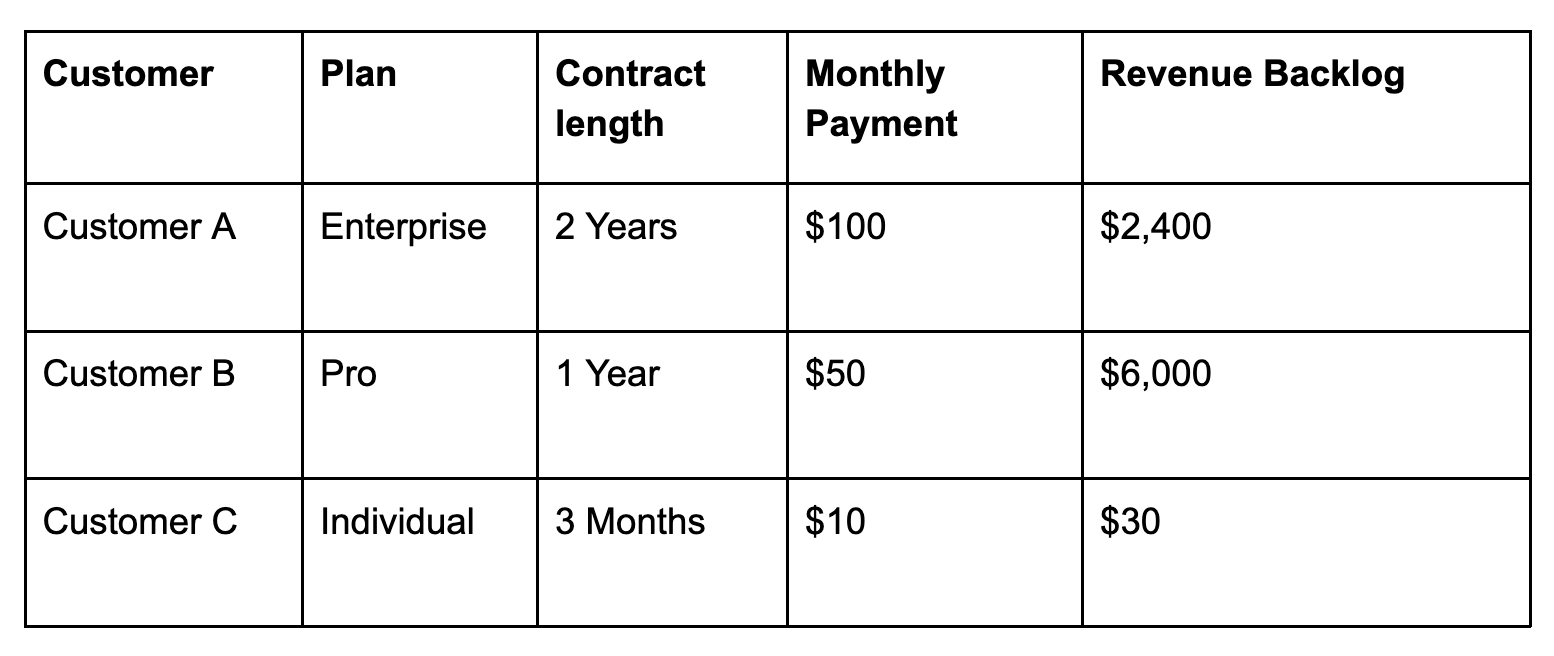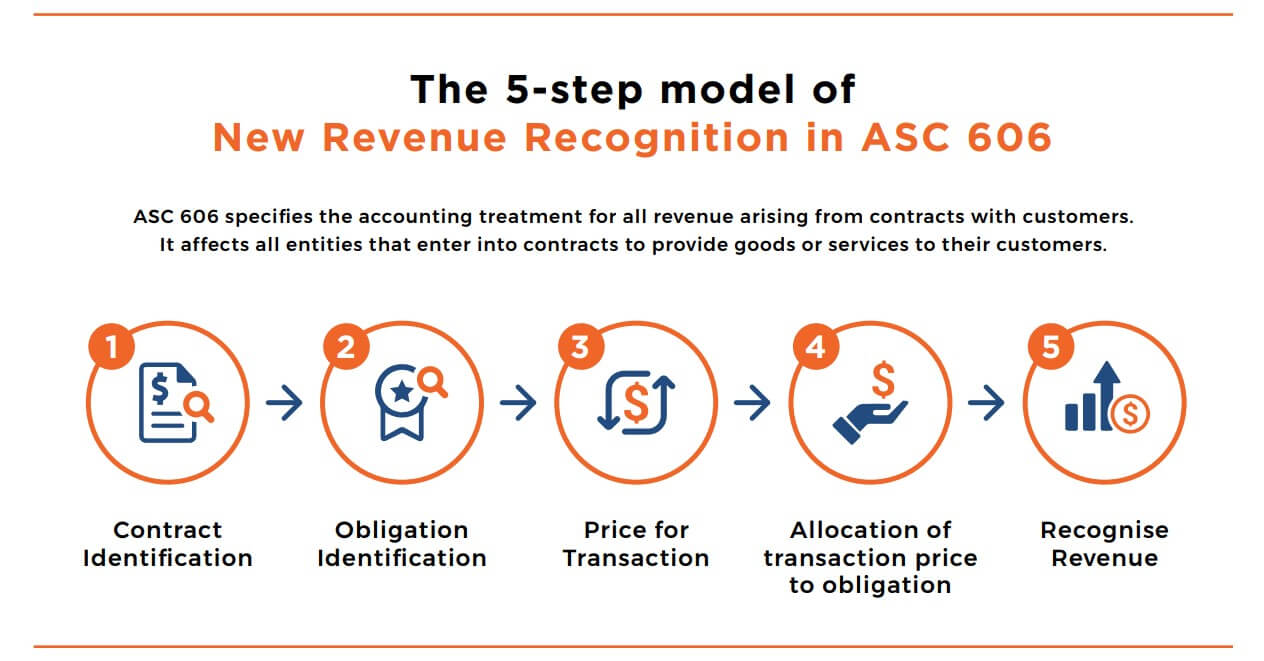PRODUCT
SOLUTIONS
- BY INDUSTRY
- B2B SaaS
- eCommerce
- E-learning
- Publishing
- BY BUSINESS SIZE
- Startup
- ScaleUp
- Enterprise
- BY BUSINESS MODEL
- Self-serve
- Sales-driven
CHARGEBEE RETENTION
Accounting and Taxes
What is Revenue Backlog?
Almost every business tracks revenue. Who doesn’t want to know how much money the company is making?
Many even report on a variety of revenue metrics, like annual recurring revenue , monthly recurring revenue (MRR), average revenue per user, or revenue churn.
But there’s a revenue measurement that’s commonly missed, and it’s a useful one: revenue backlog.
Revenue backlog can give you, your investors, and your internal stakeholders a more accurate picture of your company’s performance. But not everyone knows about it or how to use it.
We’re here to help. This article answers all of your revenue backlog questions.
What is Revenue Backlog?
Revenue backlog is the value of contracted revenue or bookings that have not yet been recognized.
In other words, it’s money that customers have promised to give you for a future service. You don’t have the cash yet, but you can count on receiving it. Knowing about it helps you get an accurate view of your current and future financial situation.
Revenue backlog differs from revenue in that it is money that you expect to receive for a future service rather than money that is actually in your account. The GAAP (Generally Accepted Accounting Principles) are strict about the way revenue is recognized and accounted for in your financial statements.
Here’s an example of revenue backlog: say your customer has committed to a $1,200 one-year subscription to your service to be paid monthly. On January 1, you bill them $100 for the first month. Your revenue backlog is now $1,100. On February 1, you bill them again, and the revenue backlog decreases to $1,000.
It’s not relevant for all business models. For example, if you’re not a SaaS business and instead you sell physical products, you probably don’t have a meaningful revenue backlog.
Who Should Track Revenue Backlog?
You’ll sometimes see revenue backlog referred to as “unrecognized revenue” or revenue that isn’t “recorded.” That just means that public companies don’t have to include it in their financial statements until the product or service is delivered.
It isn’t an official GAAP metric, and you’re not required to disclose it in your company’s annual 10-k reports. But it can still be a very valuable metric for you to track and report on internally.
Any type of business can monitor revenue backlog, but it’s especially important for SaaS companies that run on subscription models because subscriptions naturally create a backlog.
Tracking revenue backlog helps SaaS businesses with accurately forecasting cash flow, monitoring the financial health of the business, and attracting investment.
Examples of Revenue Backlog
Your revenue backlog can include a variety of sources. Some common ones for SaaS companies include:
Active subscriptions: The future value of active subscription agreements.
Pending or uninstalled subscriptions: Subscription commitments that won’t be paid for until something is installed or activated.
Future training and implementation: Training or other professional services that customers have committed to but haven’t used. These services can be recurring or one-off.
Investments: The future value of investment commitments.
For other companies like a wedding planner or caterer, it could be future bookings (minus the paid downpayment or deposit).
Why is Your Revenue Backlog Important?
For SaaS companies, tracking your revenue backlog gives you a more complete picture than revenue alone.
For example, it lets you know how risky your projections are. Will you reach your revenue target by collecting on existing contracts, or do you need to fill the gap with a lot of new customers? You can use this information to set sales quotas and decide on sales commissions.
Many SaaS contracts are multi-year, so looking at your revenue backlog can help you project your revenue years into the future.

Revenue backlog is also an important part of the valuation of your company. Investors want to see a robust revenue backlog because it’s an indication of the overall financial health of your organization — it shows your ability to fulfill the value of your current contracts. Boards and internal stakeholders are interested in revenue backlog for the same reasons.
Finally, tracking your revenue backlog helps you keep up with demand and budget for the future. You know what products and services are in demand, which makes planning and investing in R&D easier.
How Does Revenue Backlog Affect the Revenue of a Business?
Your revenue backlog doesn’t affect the official revenue you report on balance sheets and other financial documents. It does, however, affect your internal revenue forecasting.
For any subscription business, knowing your backlog is a big part of understanding your company’s finances. It reflects the cumulative value of your existing agreements, meaning you can count on the total of your backlog appearing on future revenue statements.
How to Calculate Revenue Backlog ?
The revenue backlog calculation isn’t complicated. But you have to be sure you have an accurate picture of your current contracts and agreements.
Start by adding together the value of any existing subscription agreements. Then add your expected income from any other future commitments, like training services you’ve agreed to provide or investments that will be coming your way.
The criteria are simply that you have evidence that these commitments will come through, like a signed contract.
Subtract anything you’ve already charged your customers for. For example, if a customer has already been billed for $5,000 of a $10,000 subscription, subtract that amount. The resulting number is your revenue backlog.
Of course, a SaaS company typically has multiple customers at once, and they might be on different subscription plans. Here’s an example of what that might look like:

You can use this information to create a revenue forecast by also factoring in monthly users, churn rates, and potential new subscribers. The different lengths and starting points of each contract means that your forecasted revenue will be quite different if you change the defined period of time.
What is the Difference Between Backlog and Deferred Revenue?
Revenue backlog is often confused with deferred revenue. The mix-up is understandable — both terms refer to revenue for something you’re going to provide in the future.
Here’s the difference: deferred revenue comes from advance payment for products or services that haven’t been delivered yet, while revenue backlog is contracted services that haven’t been paid for.
You can think of revenue backlog as pending revenue. You know you’re going to earn it, but you don’t have it yet. Deferred revenue is money you do have — you just haven’t fulfilled your side of the deal yet.
For example, if you haven’t charged a customer for their subscription agreement yet, that amount goes into your revenue backlog. But if you’ve invoiced for six months of a subscription that hasn’t been delivered yet, that’s deferred revenue.
Deferred revenue, unlike revenue backlog, is a GAAP financial reporting number that goes on your balance sheet. But that doesn’t mean that you should just report on deferred revenue and skip your revenue backlog.
One important difference is that your revenue backlog is more consistent and predictable than your deferred revenue. Deferred revenue may go up and down depending on how and when you invoice your customers. Revenue backlog just counts steadily down as contracts get paid off.
Tracking both backlog and deferred revenue will give you the most complete understanding of your organization’s finances.
How Does ASC 606 Affect Backlog Disclosure?
We’ve mentioned the concept of recognizing revenue a few times. For companies using accrual-based accounting, revenue is considered recognized when a performance obligation is satisfied. For example, revenue for a product is recognized when the customer takes possession of it.
Since 2018, companies have to follow a new revenue recognition standard called ASC 606, or the Accounting Standards Codification Topic 606, which dictates how revenue is recognized. ASC 606 is a significant change from past standards.
Under ASC 606, revenue is recognized if:
Risks and rewards have been transferred from the seller to the buyer.
The seller has no control over the goods sold.
Collection of payment is reasonably assured.
The amount of revenue can be reasonably measured.
Costs of earning the revenue can be reasonably measured.

So what does this new revenue standard have to do with your revenue backlog?
ASC 606 requires you to make disclosures about your unfulfilled performance obligations. Companies have to report qualitative and quantitative information on the amount of the remaining obligations and when those remaining amounts will be recognized as revenue.
This overlaps with the revenue backlog but doesn’t include all of it. For example, the ASC 606 backlog doesn’t include contracts for which “neither party has performed and which can still be terminated,” like a multi-year SaaS contract that can still be canceled.
Learn more about revenue recognition under ASC 606.
Conclusion
Revenue backlog isn’t a complicated concept, but tracking it can be a lot of work if you don’t have the right tools. You need a revenue recognition solution that can automatically calculate and analyze your revenue backlog and other accounting metrics.
We know just the one.
Chargebee RevRec lets you automate ASC 606-compliant revenue recognition for your subscription business.
You can design workflows that define, implement, and translate performance obligations into your General Ledgers and recognize revenue accordingly. Financial operations are always efficient, thanks to documented audit trails and accounting controls.
Subscription businesses can be complex with implementation fees, mid-cycle subscription changes, cancellations, and premature renewals. Chargebee is made for companies like yours. Chargebee RevRec can automate calculations for any subscription use case.
Learn more about how Chargebee can help you simplify the revenue recognition process.